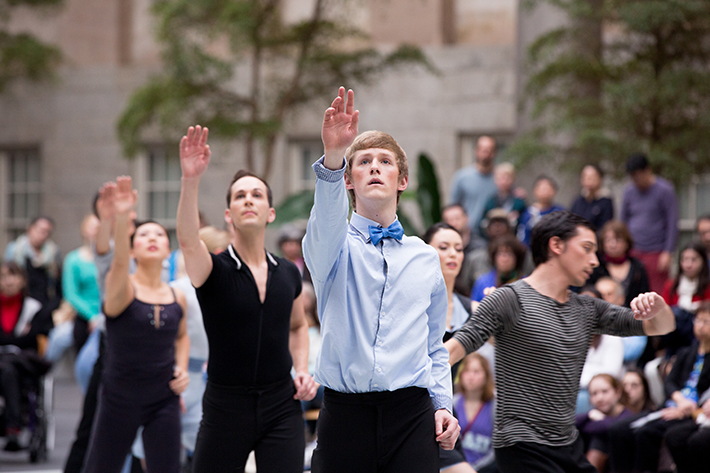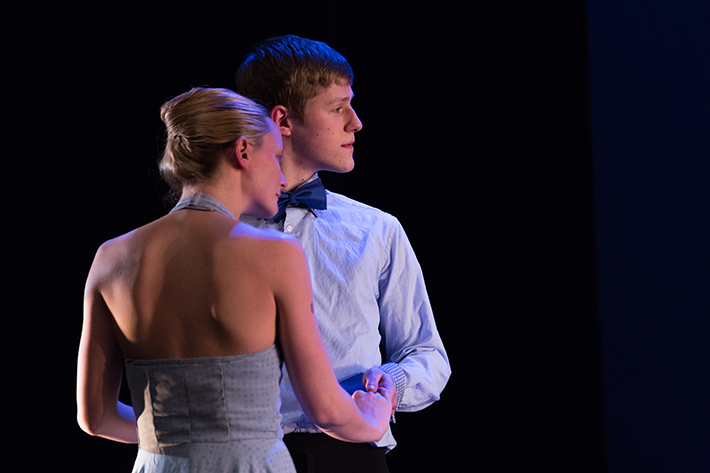With his sandy blond hair and long-limbed figure, George Washington University sophomore Ben Sanders has a perennially youthful disposition. His face is often drawn in a pensive expression, and he emotes a particularly thoughtfulness when he’s performing.
These qualities explain why at only 20, he has a professional contract with the Dana Tai Soon Burgess Dance Company (DTSBDC), led by George Washington University’s theatre and dance department chair. Mr. Sanders has toured throughout Surinam and performed at the Kennedy Center, the National Portrait Gallery and other theaters in Washington—but the even-keeled dancer is unlikely to brag. He’s polite and soft-spoken, much more interested in perfecting his technique.
He started dancing in plays at his high school in New Oxford, Pa., where he worked with dance teacher Dawn Glass, who shared the stage with Foxy Brown and Justin Timberlake. The more time Mr. Sanders spent learning new choreography, the more devoted to the craft he became.
When he began the process of selecting a university to attend, Mr. Sanders visited GW and met Mr. Burgess for the first time. It would mark the beginning of a mentorship that Mr. Sanders envisions lasting his whole career.
“Dana is such a legend here in the dance world, and he brings his expertise to everything he does,” Mr. Sanders said.
Following a childhood career as a martial arts competitor, Mr. Burgess started dancing and choreographing, eventually teaching at the Kirov Academy of Ballet, the Washington Ballet and the Hamburg Ballet, to name a few places. In 1992, he launched his own company, where he creates some of the city’s most fluid, thought-provoking modern dances that explore his mixed ethnicity and Korean ancestry.
Mr. Sanders was keenly aware of all these details when he took Mr. Burgess’ course “Dance in Community Settings” as a freshman. The class requires that young dancers complete internships to learn about the back end of the dance business. Mr. Sanders asked whether he could work at the professor’s own company through the class and started an internship in which he handled administrative tasks, archived videos and helped backstage. Mr. Burgess also gave Mr. Sanders the opportunity to practice with the company. Mr. Sanders remembers the first time he entered the studio, shaky with nerves.
“I had watched these dancers from backstage, thinking, ‘I want to be that, I want do that.’ When I entered the room for the first time, I definitely felt intimidated,” he said.

Sophomore Ben Sanders (center) performs at the National Portrait Gallery.
That memory of an anxious freshman is a far cry from the dancer who looks completely at home late one Friday night at Georgetown Day High School, DTSBDC’s rehearsal space, where the company is preparing for performances at NASA and the Kreeger Museum. The school is quiet, save for the melodies coming from the dance room speakers. Mr. Burgess is standing in the center with his head cocked to the side as dancers try out new movement phrases.
When he gives instructions, they seem vague to an outsider. But everyone in DTSBDC understands the language.
“Think about your favorite childhood toy,” Mr. Burgess says pensively. “Now, make it 40 times larger and trace it from the outside with your movements.”
The dancers are quiet for a moment and then slowly, they begin moving. Mr. Burgess nods as he examines each interpretation, making small adjustments to his directions: “Good, now turn the toy on its side.” “Can you show me texture?”
Mr. Sanders said that part of the reason Mr. Burgess’s choreography is so distinct is because he encourages teamwork and listens to ideas from everyone in the room.
“He never says, ‘You’re doing it wrong.’ He’ll go, ‘That’s an interesting way to do it, but let’s try an experiment and see how this looks.’ It feels collaborative as opposed to director and pupil,” Mr. Sanders said.
Mr. Sanders rehearses one piece with Connie Lin Fink-Hammack, a principal dancer. They’re at ease with one another—when he forgets a step, she bursts into giggles and starts from the beginning to give Mr. Sanders a second try.
There’s another bond that ties the sinewy dancers together—Ms. Fink-Hammack is a professor at GW. Five other members of the company have degrees from the university, and one is finishing an M.F.A.
“They’ve been through everything I’m feeling as a student,” Mr. Sanders said. “If I come to practice really stressed out, they calm me down.”
Earlier this semester, Mr. Sanders was juggling the university’s production of “Urinetown,” the dance department’s “DanceWorks” and midterms. When he’s overwhelmed, the company and Mr. Burgess are his central support systems. In addition to helping him grow as a dancer, Mr. Sanders’ experience with Mr. Burgess has given a bird’s eye view of running a company—which he hopes to do someday.
“This gets me a little bit ahead of the game—I’m just so lucky that Dana has involved me in his work,” he said.

Sophmore Ben Sanders and Sarah Halzack, B.A. '06, perform at the Kennedy Center in February.


